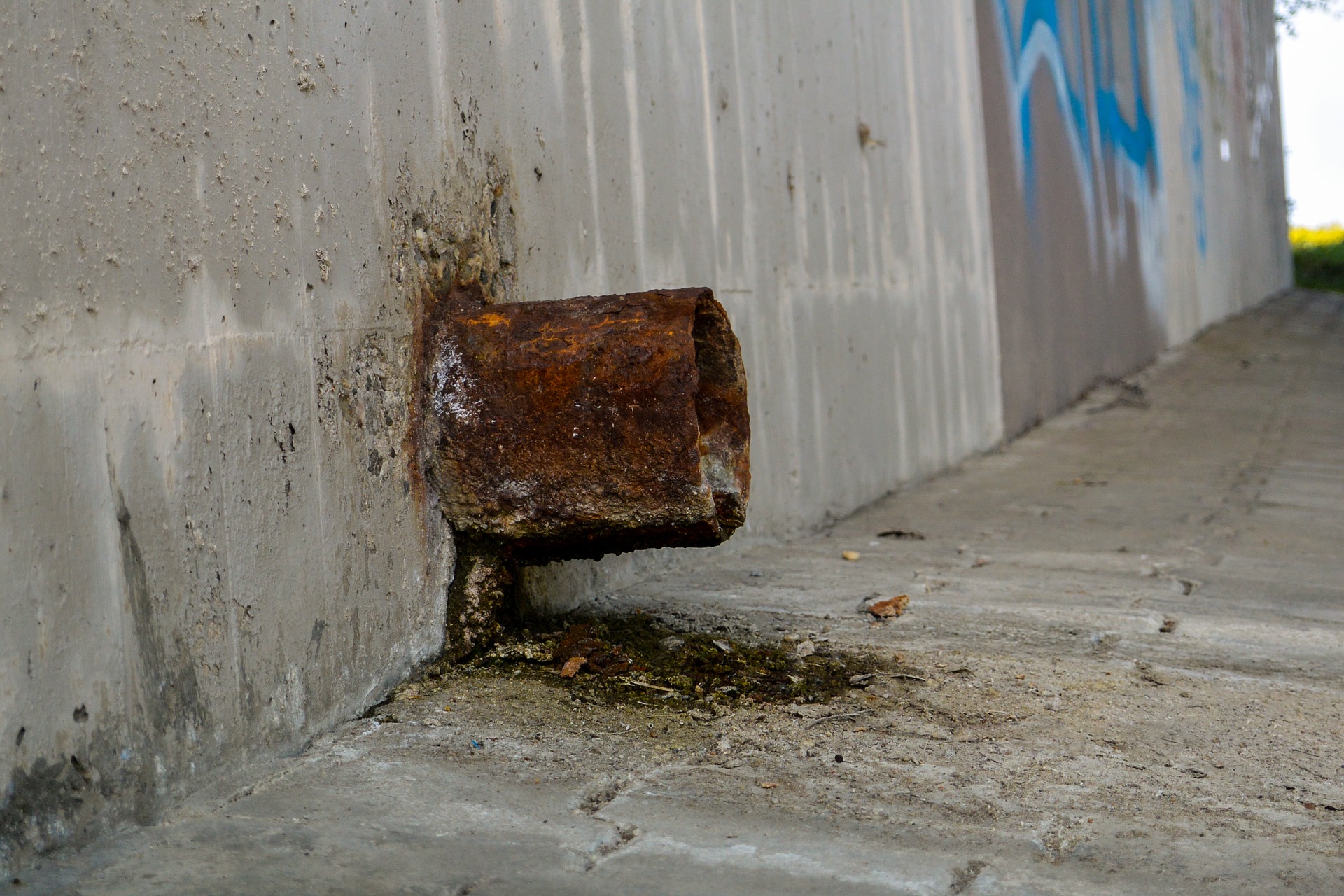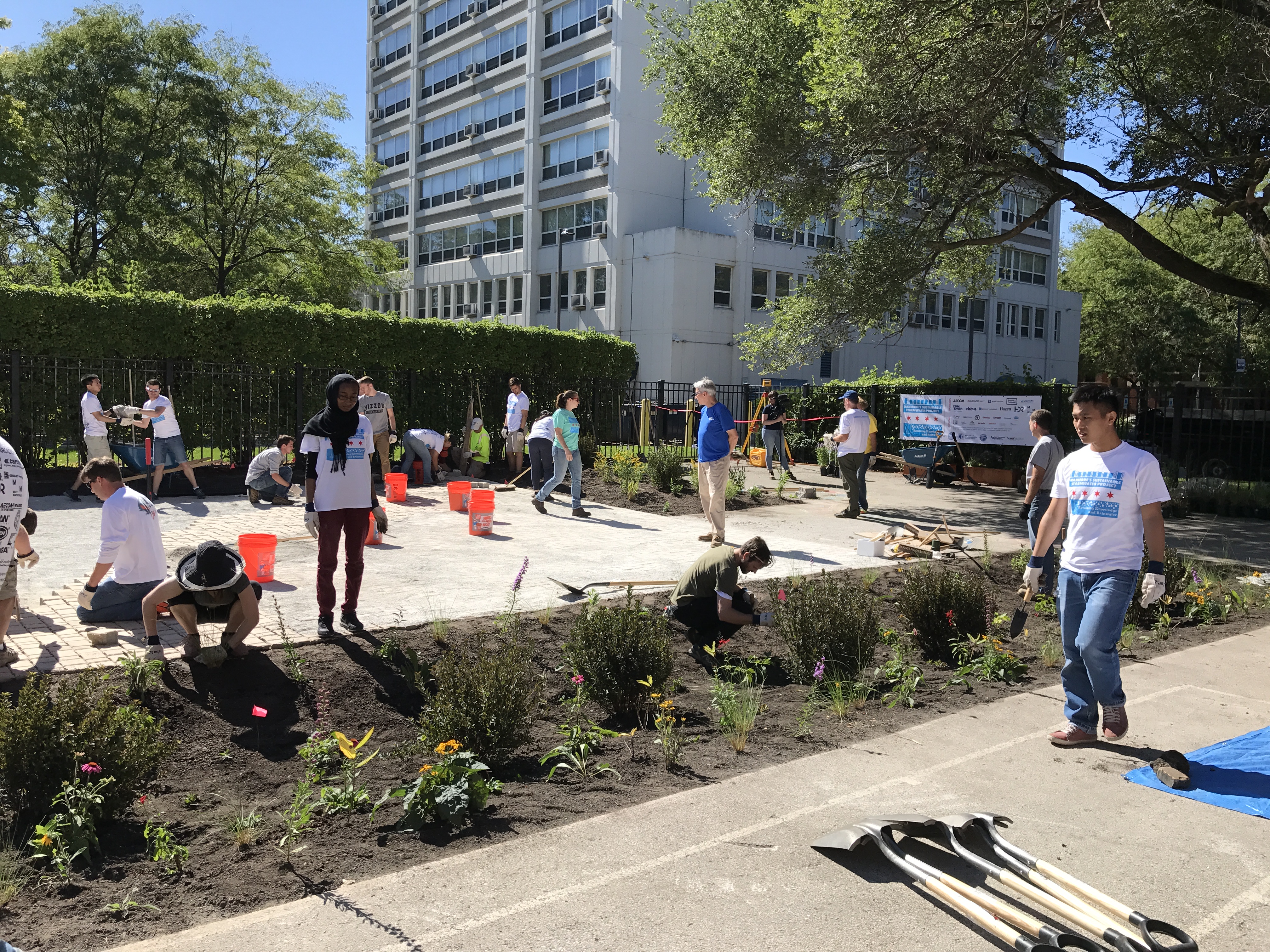In solving the problem of sanitary sewer overflows, the City of Columbus wanted to spend its capital dollars above ground, transforming neighborhoods and creating permanent jobs. Rather than build little-used tunnels, the city decided to pursue a community-based integrated plan called Blueprint Columbus. This program is unique in its focus on private, residential inflow and infiltration (I/I) removal. The four-pillar plan utilizes green infrastructure, lateral lining, roof water redirection, and sump pumps to eliminate I/I. This unique approach, with its emphasis on smaller, neighborhood-level projects, created new workforce development opportunities. Working with established nonprofits and a local community college, the City of Columbus will provide training for green infrastructure installation and maintenance to local small businesses and disadvantaged residents. The city estimates that over 30 years, Blueprint Columbus will boost the local economy by $3.3 billion in regional output, $900 million in earnings, and 700 additional jobs, three times the amount anticipated under the gray-only scenario.
Traditional Wet Weather Solutions
Since its wet weather management plan (WWMP) was submitted in 2005, the City of Columbus has spent over a billion dollars on the plan. It has expanded the wet weather capacity of the city’s two wastewater treatment plants, each by 50%, reducing wet weather overflows and bypasses. In 2012, the city started work on a combined sewer overflow (CSO) tunnel, which when complete in 2017, will have virtually resolved Columbus’ CSO issues.
However, sanitary sewer overflows (SSO) and basement backups continue to be a problem for Columbus. As of 2012, there were 85 SSOs in the city at 26 different locations. At an estimated $2.5 billion, the traditional grey solution to the city’s SSO woes includes two large tunnels that would operate only 5 or 6 times per year on average. This plan would do little to improve stormwater quality, and runoff is one of the leading causes of water quality impairment in central Ohio.
The Blueprint Approach
In 2012, Columbus Mayor Michael B. Coleman challenged the city’s Department of Public Utilities to rethink its approach to complying with its wet weather consent orders. “The consent orders mandate that we spend billions of dollars, but not how that money is spent,” said Mayor Coleman. “We can use this mandate as an opportunity to improve neighborhoods, create local jobs, and clean our rivers.”
This new direction coincided with the U.S. Environmental Protection Agency’s (EPA) green infrastructure strategy and Integrated Planning Framework.
“Under Mayor Coleman’s direction and in light of the Integrated Planning Framework, we approached Ohio EPA to propose a fresh approach,” said Greg Davies, director of the city’s Department of Public Utilities. The city wanted an approach that would help stabilize and improve older neighborhoods “while also contributing needed jobs to our local economy.”
Green Solutions for SSOs
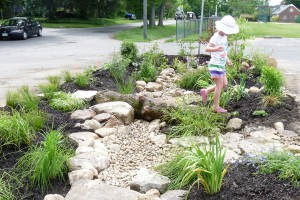
Visible green infrastructure solutions will help the City of Columbus provide long-term improvements in the community while creating more jobs and doing more for water quality. Image by Alice Waldhauer
The city is now updating its consent decree and will resubmit it in September 2015 as an integrated plan. Blueprint Columbus focuses on two major goals, removing stormwater from sanitary sewers, also known as I/I removal, and routing runoff to green infrastructure. To achieve these goals, the city will use an integrated, four-pillar plan that incorporates residential-level green infrastructure, lateral lining, roof water redirection, and sump pumps.
The city’s SSOs are caused primarily by stormwater infiltrating private laterals. When it rains, these laterals carry excess water into the sanitary sewer system, exceeding its capacity and leading to overflows and basement backups. Stormwater from directly connected roof drains and ineffective splash blocks also travels into the laterals from foundation drains.
The heart of the program and what makes it unique is the large scale pursuit of eliminating excessive I/I from homes.
“We know that more than half of the I/I is coming in from our older neighborhoods,” said Dax Blake, administrator for the Department of Public Utilities’ Division of Sewers and Drains. This makes the project challenging for a number of reasons, which include the need to access thousands of private homes. In addition, the city had to take its Storm Water Management Model (SWMM) to the individual home scale, a new level of detail. “I am very proud of the modeling effort we have undertaken to support Blueprint,” Blake said. “It is state of the art.”
The city will add approximately 4 to 8 ha (10 – 20 ac) of green infrastructure per year, including improvements in the public right-of-way, such as porous pavement sidewalks, rain gardens, and urban trees. The city also envisions creating pocket parks, and the use of vacant lots is already underway.
“Green infrastructure provides so many benefits to our city,” Davies said. “In addition to the stormwater benefits, we can create real amenities for our neighborhoods. In fact, our first porous pavement basketball court will be built this summer.” That court will be part of a new 0.4-ha (1-ac) park that can treat stormwater from almost 2.5 ha (6 ac) of drainage.
New Business and Job Opportunities
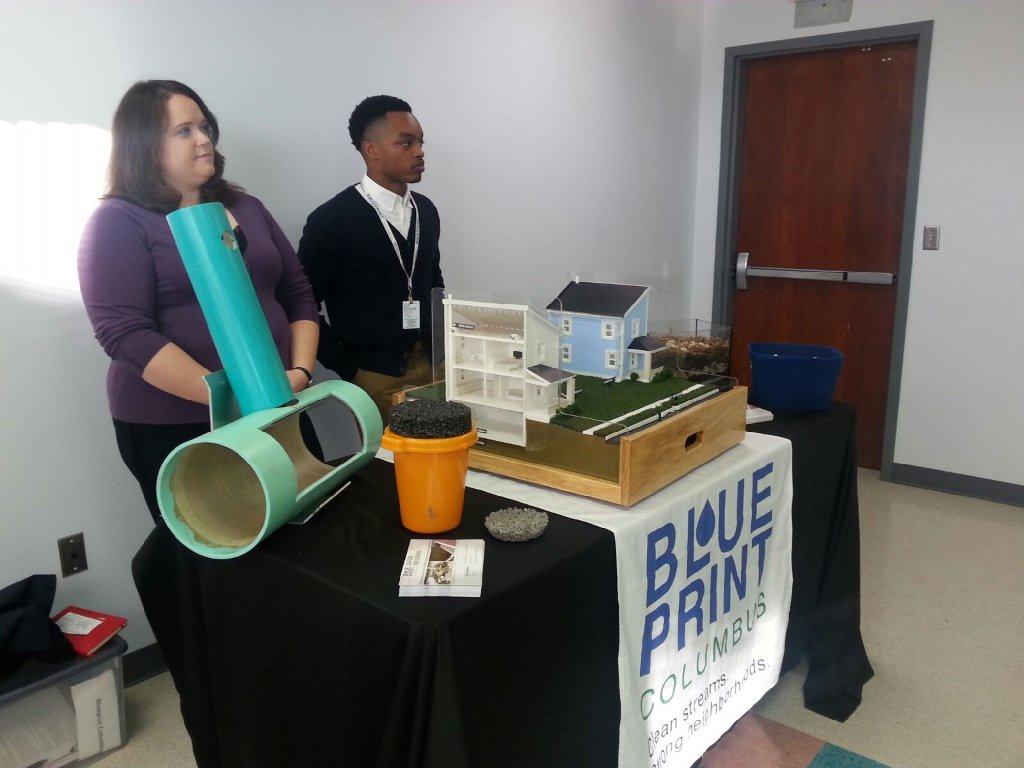
Members of the Blueprint outreach team stand ready to explain to small business owners how residential stormwater runoff causes sewer system issues using a model home specifically created for the Blueprint initiative.
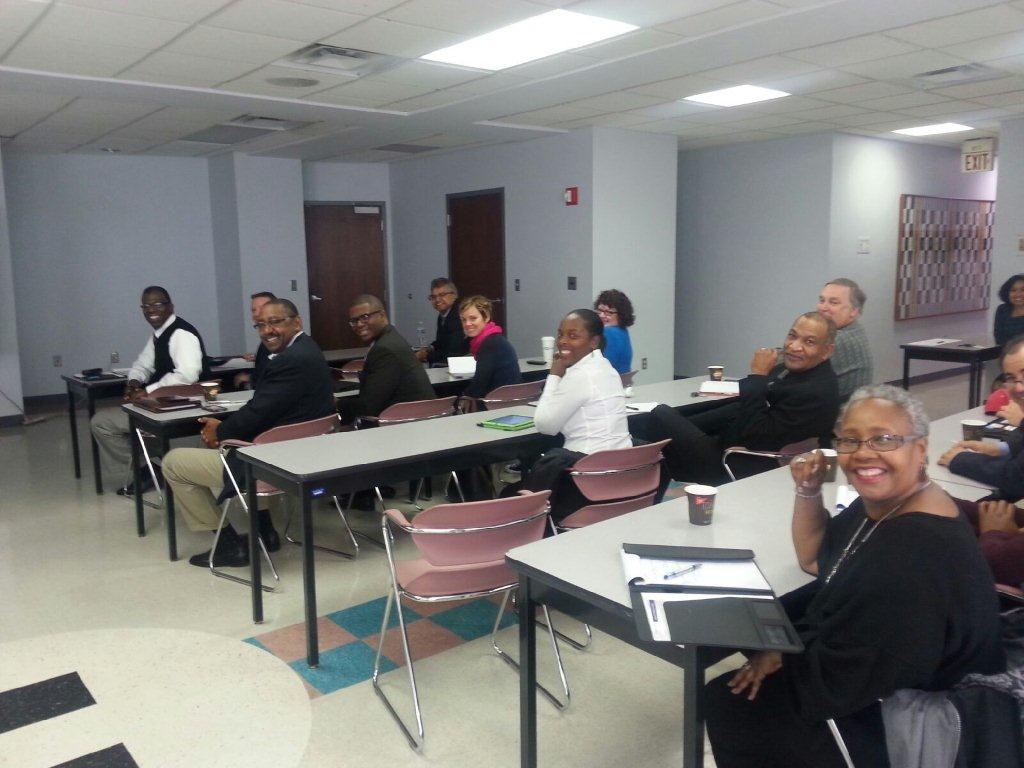
A group of Columbus small business owners gather at Columbus Urban League to learn about Blueprint contracting opportunities. Businesses included small engineering, construction, and landscaping firms. Images: City of Columbus.
Columbus Blueprint is a community-based approach, and many of the pillars utilize private property. “There has to be a close relationship between the city and the homeowner, so we are being very deliberate and intentional in making this a rewarding experience for our residents,” said Keena Smith, assistant director for workforce and economic development for the Department of Public Utilities. With a very active outreach program and an open-minded community, “the greatest successes the city has seen so far have been those in the community.”
With construction on some Blueprint projects slated to begin this year, the city will need trained professionals for installation. Green infrastructure also requires perpetual maintenance, which is another vehicle for job creation. The city estimates that over 30 years, Blueprint Columbus will boost the local economy by $3.3 billion in regional output, $900 million in earnings, and 700 additional jobs. The program is expected to create more than 3 times as many jobs as the original plan that relied only on traditional solutions.
Columbus is looking to keep those jobs local through a new training and certification program focused on green infrastructure design and maintenance. The city also sees Blueprint Columbus as a great opportunity to foster the development of new small businesses and grow existing companies and is actively outreaching to them about training opportunities. Graduates of the city’s training program will receive a certificate that is equivalent to experience when bidding on Blueprint projects.
“The workforce development initiative is a big part of the community benefits provided by Blueprint,” Smith said. “We want to develop our labor pool and prepare small businesses.”
According to Smith, the biggest challenge for small businesses in bidding on projects is that they feel behind the investment and learning curve. “We want to lower the barriers to entry,” she said. “We are fostering the entry of small businesses into this market by providing instruction and education.”
Just as important, the program gives small businesses the opportunity to initiate relationships with city staff and local experts. Columbus also is encouraging larger primary contractors to work with and mentor local small business subcontractors.
Training Restored Citizens
Blueprint Columbus has opened an avenue for new partnerships, and through its partners, the city is leveraging a strong network of existing, mature nonprofits that focus on workforce development. Partners include the Columbus Urban League and Alvis House, both of which help disadvantaged populations or disenfranchised groups develop employable skills and gain reentry into the workplace. For instance, Columbus Urban League’s Transitions program helps restored citizens, those who are coming back into the workplace from incarceration.
These organizations will feed graduates of their life skills classes into the Blueprint Columbus training program, pre-screening potential students and helping the city identify top quality candidates.
The City of Columbus also is partnering with Columbus State Community College, which already has a local workforce training framework, experienced faculty, and space to host the classroom portion of the program. The 6-week program will take place 4 hours per day, 3 days per week and will cover topics such as the hydrologic cycle, soil basics, vegetated systems, hardscape, and greenscape maintenance. It will also include a 10-hour Occupational Safety and Health Administration construction safety course, which is already provided by the community college.
Additionally, the program will include field trips and hands-on maintenance training with the city’s existing green infrastructure facilities.
The training program will kick off in March, and there will be two sets of graduates this year, in the spring and fall. Blueprint projects slated to start construction this year and active projects already in the works are opportunities to bring newly trained graduates into the sector.



